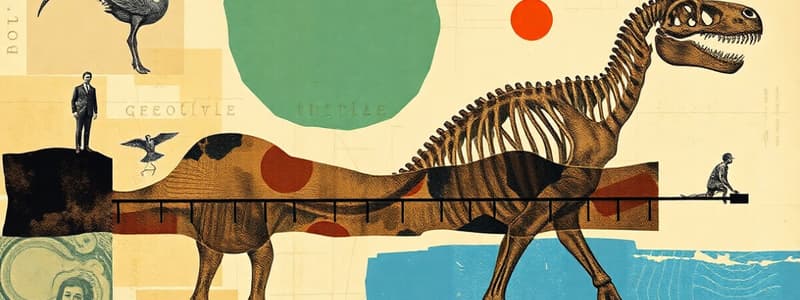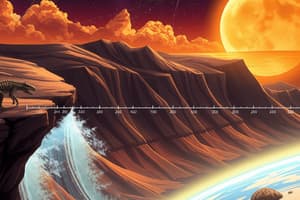Podcast
Questions and Answers
What is the largest time unit in the geologic time scale?
What is the largest time unit in the geologic time scale?
- Epoch
- Era
- Period
- Eon (correct)
Which principle states that sedimentary rocks are deposited in horizontal layers?
Which principle states that sedimentary rocks are deposited in horizontal layers?
- Superposition
- Lateral Continuity
- Original Horizontality (correct)
- Cross-Cutting
During which eon did fossil evidence suggest that simple life-forms appeared?
During which eon did fossil evidence suggest that simple life-forms appeared?
- Archean (correct)
- Proterozoic
- Hadean
- Phanerozoic
What does superposition state regarding rock layers?
What does superposition state regarding rock layers?
What is the main focus of relative-age dating?
What is the main focus of relative-age dating?
Which principle indicates that an intrusion is younger than the rock it cuts across?
Which principle indicates that an intrusion is younger than the rock it cuts across?
How long do epochs generally last?
How long do epochs generally last?
Which concept suggests that layers of rock extend until the environment changes?
Which concept suggests that layers of rock extend until the environment changes?
Flashcards
What are fossils?
What are fossils?
Fossils are the preserved remains, traces, or imprints of ancient organisms, often found embedded in rocks. Studying rock layers and the fossils within them helps geologists unravel Earth's history and understand past environments.
What is the geologic time scale?
What is the geologic time scale?
The geologic time scale is a visual timeline of Earth's history, spanning from its formation 4.6 billion years ago to the present.
What is an eon?
What is an eon?
An eon is the largest unit of geologic time. The Precambrian eon encompasses the first 90% of Earth's history and witnessed the formation of Earth and the emergence of early life.
What are eras?
What are eras?
Signup and view all the flashcards
What are periods?
What are periods?
Signup and view all the flashcards
What are epochs?
What are epochs?
Signup and view all the flashcards
What is relative-age dating?
What is relative-age dating?
Signup and view all the flashcards
What is the principle of original horizontality?
What is the principle of original horizontality?
Signup and view all the flashcards
Study Notes
Organizing Time
- Fossils are remains, traces, or imprints of ancient organisms found in rocks.
- Studying rock layers and fossils helps geologists understand Earth's history and past environments.
- The geologic time scale is a graphic representation of Earth's history from 4.6 billion years ago to the present.
Geologic Time Scale
- An eon is the largest unit of time.
- The three earliest eons (Precambrian) make up 90% of geologic time.
- During the Precambrian, Earth formed and became hospitable to modern life.
- Simple life-forms appeared during the Archean Eon.
Eras
- Eras are the next largest units of time, typically tens to hundreds of millions of years in duration.
- Eras are made up of eons.
Periods
- Eras are divided into periods.
- Periods typically last tens of millions of years.
Epochs
- Periods are divided into epochs.
- Epochs usually last hundreds of thousands to millions of years.
Relative Age Dating
- Relative-age dating places rock layers and geologic events in the order they formed or occurred.
- No dates or numbers are used.
Principles of Relative Dating
- Original Horizontality: Sedimentary rocks are deposited in horizontal layers.
- Superposition: In undisturbed rock sequences, the oldest rocks are on the bottom, and layers get progressively younger upward.
- Lateral Continuity: Layers of rock extend in all directions until the environment changes.
- Cross-Cutting Relationships: An intrusion or fault is younger than the rock it cuts across.
- Inclusions: Rock fragments (inclusions) within a layer are older than the layer containing them.
Correlation
- Correlation matches rock outcrops in different locations.
- A key bed is a rock layer that serves as a time marker.
- Index fossils are easily recognized, abundant, and widely distributed fossils.
- Index fossils can be used to correlate rock layers of the same age but not necessarily the same rock type.
Studying That Suits You
Use AI to generate personalized quizzes and flashcards to suit your learning preferences.




